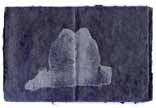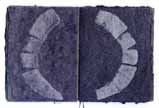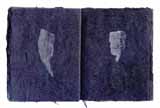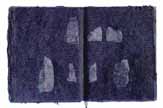







During the spring of 1992, Caren Heft made a number of visits to her terminally ill father in Bay County, Florida. On June 10, late in the afternoon, she went for a walk through the white sands at the edge of a small lake. There she found the bones of a turtle. She made xerographic copies of the bones, had zinc plates made from them, and printed a book of the bones on paper she had made for another project. On her final visits to her father, she bound the books. We reproduce four openings from the book at this site, in thumbnails above, which can be enlarged by clicking on the images.Previously, Heft had not only made a number of similar gray papers, but had also made gallery-sized assemblages out of canvas that looks similar to the paper. Initially, the paper and the canvas look like ash, and seem so frail that if you touched them they would disintegrate. This quality almost insists that the viewer handle the paper, and discover that it is nearly as strong as canvas. More than most book artists, Heft insists that her papers take aggressive roles in her books. In this case, the contrast of seeming fragility and real endurance forms an inseparable part of her meditation on mortality and the passage of time.
The passage of time plays itself out in several ways in the book. The process of disintegration in the turtle makes itself apparent immediately. The nature of "siting" with the mortally ill and with the deceased in the southern U.S. - a time to say goodbye, to let go, and also to renew ties with family and friends - becomes as deeply embedded in the significance of the book as the character of the paper.
Heft printed the book in a metallic silver ink which forms an odd harmony with the gray paper that can seem alternately eerie and natural, subdued and insistent. The textures of the bones create fascinating patterns, inviting close examination. If you look closely at the bones the print seems to merge with paper. Despite the intermediate steps involved in printing, the bones seem directly imprinted on the paper, like lead type. Aside from the title and colophon, the book contains no text. The bones and the paper say all there is to say.
Copyright © 1992 by Caren Heft.
Light and Dust Mobile Anthology of Poetry.